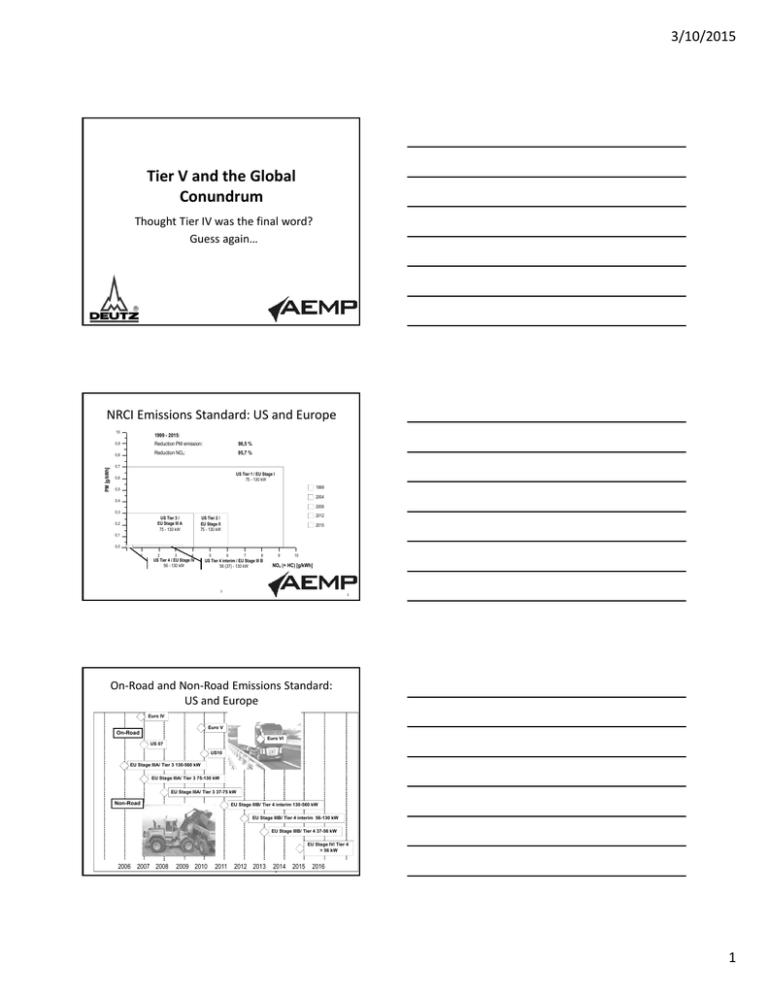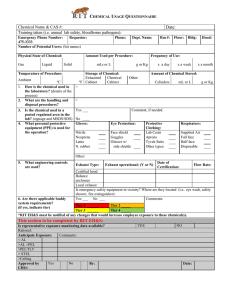Tier 5 and the Global Conundrum
advertisement

3/10/2015 Tier V and the Global Conundrum Thought Tier IV was the final word? Guess again… NRCI Emissions Standard: US and Europe PM [g/kWh] 10 1999 - 2015: 0,9 Reduction PM emission: 96,5 % 0,8 Reduction NOx: 95,7 % 0,7 US Tier 1 / EU Stage I 75 - 130 kW 0,6 1999 0,5 2004 0,4 2006 0,3 US Tier 3 / EU Stage III A 75 - 130 kW 0,2 2012 US Tier 2 / EU Stage II 75 - 130 kW 2015 0,1 0,0 1 2 3 4 US Tier 4 / EU Stage IV 56 - 130 kW 5 6 7 8 US Tier 4 interim / EU Stage III B 56 (37) - 130 kW 9 10 NOx (+ HC) [g/kWh] 2 2 On‐Road and Non‐Road Emissions Standard: US and Europe Euro IV Euro V On-Road Euro VI US 07 US10 EU Stage IIIA/ Tier 3 130-560 kW EU Stage IIIA/ Tier 3 75-130 kW EU Stage IIIA/ Tier 3 37-75 kW Non-Road EU Stage IIIB/ Tier 4 interim 130-560 kW EU Stage IIIB/ Tier 4 interim 56-130 kW EU Stage IIIB/ Tier 4 37-56 kW EU Stage IV/ Tier 4 > 56 kW 2006 2007 2008 VE-S - Dr. Müller 2009 2010 3 2011 2012 2013 2014 2015 2016 23.10.2014 1 3/10/2015 Compare Current EU Non‐road and On‐ road Standards EU On‐road “Euro” EU Non‐road “Stage” 4 C.A. Tissera Drive for Emission legislation in EU Local regulations Contractor requirements for DPF ► German Railways requiring DPF for urban construction sites ► Germany: Construction sites where TRGS* apply (indoor use & tunnel construction) ► Mining applications in general ► Local authorities increasingly insist on machines with DPF *TRGS: Technical Rules for Hazardous Substances Engine and Equipment Manufacturers Position ► Prefers solutions for a single emissions compliance platform where machines can be used globally ► For EU Stage V: Most likely with DPF there is no installation change from Stage IV to Stage V DPF required European Low Emission Zones ► Introduce local regulations requiring PM filters in urban areas earlier than EU Stage V 5 EU Stage V (Proposed initiation‐ 2019) – – – – – – – Incorporates standards for < 19 kW and > 560 kW Particle Number (PN) and Particle Mass (0.015 g/kW) for 19 ‐ 560 kW Same NOx limits as US Tier 4 Final Staggered introduction 2019 / 2020 proposed PN requires DPF same as Switzerland today Include gaseous fuel ‐ CH4 (Methane) limit Less transition flexibility (EU flex) • Eliminate equipment flexibility provisions – Decrease sell‐off period • • Engine manufactured in last 6 months of previous Stage Machine manufactured in first 12 mo. of new Stage – EU version of delegated assembly: ‘Separate Shipment’ provision – Reduced/eliminated opportunity for new previous‐Stage replacement engines – Formal process for prototype testing – Stationary engines remain out of scope C.A. Tissera 6 2 3/10/2015 EU Stage V (From 2019) 1 x 1012 = 1,000,000,000,000 = 1 Trillion Particles • Particle number (PN) limit of 1x1012 #/kWh will apply to EU NR engines from 19 ‐ 560kW, requiring wall‐flow particulate filters. 7 C.A. Tissera How Small Are We Talking About? – Fine and Ultra‐fine particles are a component of PM – Ultra‐fine particles are <100 nm C.A. Tissera 8 EU Standard ‐ Particle Measurement Program (PMP) – To date, PM emissions are regulated on a mass basis (g/bhp‐hr) by collecting PM on a filter placed in a diluted exhaust stream and weighing the PM collected on the filter. – PMP protocol involves only the measurement of solid particles. – EU method removes volatile particles out of the exhaust stream prior to entering the sampler. – Measurement method samples particles above a certain size range. – EU has established a PN number standard for • Light‐duty diesel vehicles ‐ EURO V: 6 X 1012 particles per kilometer. • Heavy‐duty vehicles ‐ EURO VI: 6 X 1011 per kWh and 8 X 1011 per KWh based on test cycle. • Non‐road Stage V PN limit is 1x1012 per kWh based on test cycle for 19 ‐ 560kW. C.A. Tissera 9 3 3/10/2015 Rational for a PN Standard – Researchers: • Calling for new emission standards and measurement methods since PM reduced by 99% from Tier 1 levels, has made mass‐based method less accurate • PN is a better metric than mass. – Health Effects: • Speculation that fine and ultrafine particles are more harmful to human health than larger particles. • Very small particles contribute insignificantly to the mass of PM but compose a very large fraction of the number of particles. • PN # provide a better indication of the potential health effects of all PM emissions. 10 C.A. Tissera Rational for a PN Standard – Measurement Accuracy: • Belief that accurate measurement of PM mass is no longer technically feasible. • With DPF technology, PM emissions from new engines are approaching measurement detection limits. – DPF Forcing Standard: • EU, PM emissions generally require use of EAT systems with catalyzed DPFs that result in PM well below the mass‐based standard. • Regulatory agencies and health advocates support DPFs due to its ability to reduce PM to near zero. • As some engines meet the current PM mass standard (Stage IV) without DPFs, agencies don’t support such approaches since readily available DPF would result in even lower PM levels. • PN standards are viewed as a way for agencies to mandate the use of DPFs on all engines. C.A. Tissera 11 EPA and CARB PN Implementation Issues – Definition of Particle: • Exhaust particles vary widely from large solid to ultrafine volatile particles, its type and size range of must be defined. – Condition of the Exhaust to be Sampled: • Since exhaust dilution, temperature, flow rates effects PN, a new testing protocol must be defined – Form of the Standard: • Mass‐based standard generated over the test cycle reported as g/bhp‐hr • PN results are compiled by taking instantaneous real‐time measurements and offer a variety of options for reporting – Instrumentation and Calibration: • Mass measurement uses a balance scale that weigh a standard weight • PN instruments from different companies may not give same results. • No standard calibration norm for the PN instruments. C.A. Tissera 12 4 3/10/2015 PN Implementation Drive in the U.S. – In the United States, U.S. EPA has not expressed much interest in establishing a PN standard – CARB’s interest and participation in PN research and health concerns regarding PM and traffic emissions, increase the prospects for eventual adoption of a PN emission standards. – California’s interest in establishing a PN standard from the fact that some manufacturers are able to meet the current mass‐ based standard w/o DPFs. – Many believe that CARB will be the first to take up regulatory initiative to establish a PN standard in North America forcing manufacturers to use DPFs. – No PN standard is proposed by EPA or CARB to date. C.A. Tissera 13 Ref: United Nations Environment Program C.A. Tissera 14 Brazil CONAMA Resolution: Limiting exhaust emissions from new construction and Ag machinery. MAR – I emission phased from 2015–2019: Depends on power category and type of machinery No emissions label required, No Deterioration Factor (DF) test requirements Witnessed emission tests 1/1/2015: Stage III A Emissions (~Tier 3) New Launches 37 - 560 kW For engines - Not commercialized by December 2013. Engines that were commercialized by December 2013, but had a new ECU or change in power are considered a new launch. For machines - that were commercialized, but changed settings, eg: received a new engine, or other change that makes it different from what was commercialized in 2013. C.A. Tissera 15 5 3/10/2015 China • Currently ‐ China Stage II (similar to EU Stage II ~Tier 2) • Rulemaking underway for China Stage III (~ EU IIIA, Tier3/4i) and Stage IV (Tier 4F) • Standards for engines <19 kW and useful life requirement for engines <19kW • On going discussions on – Exemption provisions and Sulfur content in diesel fuel • Durability Tests (DF) ‐ DF Grouping and Testing Provisions Stage III (0‐36 kW) NOx+NMHC 7.5 7.5 CO 5.5 5.5 0.6 0.3 PM C.A. Tissera Stage IV (0‐36 kW) units: g/kW‐hr 16 Japan • Smoke requirement for in‐use tests. • Tier 4F equivalent standard for 19‐55 kW is different from Tier 4i equivalent only in blow‐by gas requirement. • Tier 4i and Tier4F in brackets (ex: 23m) represent number of months in 'flex grace period' in which previous Tier products can continue to be produced. 17 India C.A. Tissera 18 6 3/10/2015 Thank You! Questions? 7



